Keyu Wang
Demystifying the Roles of LLM Layers in Retrieval, Knowledge, and Reasoning
Oct 02, 2025Abstract:Recent studies suggest that the deeper layers of Large Language Models (LLMs) contribute little to representation learning and can often be removed without significant performance loss. However, such claims are typically drawn from narrow evaluations and may overlook important aspects of model behavior. In this work, we present a systematic study of depth utilization across diverse dimensions, including evaluation protocols, task categories, and model architectures. Our analysis confirms that very deep layers are generally less effective than earlier ones, but their contributions vary substantially with the evaluation setting. Under likelihood-based metrics without generation, pruning most layers preserves performance, with only the initial few being critical. By contrast, generation-based evaluation uncovers indispensable roles for middle and deeper layers in enabling reasoning and maintaining long-range coherence. We further find that knowledge and retrieval are concentrated in shallow components, whereas reasoning accuracy relies heavily on deeper layers -- yet can be reshaped through distillation. These results highlight that depth usage in LLMs is highly heterogeneous and context-dependent, underscoring the need for task-, metric-, and model-aware perspectives in both interpreting and compressing large models.
OmniVTLA: Vision-Tactile-Language-Action Model with Semantic-Aligned Tactile Sensing
Aug 12, 2025Abstract:Recent vision-language-action (VLA) models build upon vision-language foundations, and have achieved promising results and exhibit the possibility of task generalization in robot manipulation. However, due to the heterogeneity of tactile sensors and the difficulty of acquiring tactile data, current VLA models significantly overlook the importance of tactile perception and fail in contact-rich tasks. To address this issue, this paper proposes OmniVTLA, a novel architecture involving tactile sensing. Specifically, our contributions are threefold. First, our OmniVTLA features a dual-path tactile encoder framework. This framework enhances tactile perception across diverse vision-based and force-based tactile sensors by using a pretrained vision transformer (ViT) and a semantically-aligned tactile ViT (SA-ViT). Second, we introduce ObjTac, a comprehensive force-based tactile dataset capturing textual, visual, and tactile information for 56 objects across 10 categories. With 135K tri-modal samples, ObjTac supplements existing visuo-tactile datasets. Third, leveraging this dataset, we train a semantically-aligned tactile encoder to learn a unified tactile representation, serving as a better initialization for OmniVTLA. Real-world experiments demonstrate substantial improvements over state-of-the-art VLA baselines, achieving 96.9% success rates with grippers, (21.9% higher over baseline) and 100% success rates with dexterous hands (6.2% higher over baseline) in pick-and-place tasks. Besides, OmniVTLA significantly reduces task completion time and generates smoother trajectories through tactile sensing compared to existing VLA.
Fraud-R1 : A Multi-Round Benchmark for Assessing the Robustness of LLM Against Augmented Fraud and Phishing Inducements
Feb 18, 2025Abstract:We introduce Fraud-R1, a benchmark designed to evaluate LLMs' ability to defend against internet fraud and phishing in dynamic, real-world scenarios. Fraud-R1 comprises 8,564 fraud cases sourced from phishing scams, fake job postings, social media, and news, categorized into 5 major fraud types. Unlike previous benchmarks, Fraud-R1 introduces a multi-round evaluation pipeline to assess LLMs' resistance to fraud at different stages, including credibility building, urgency creation, and emotional manipulation. Furthermore, we evaluate 15 LLMs under two settings: 1. Helpful-Assistant, where the LLM provides general decision-making assistance, and 2. Role-play, where the model assumes a specific persona, widely used in real-world agent-based interactions. Our evaluation reveals the significant challenges in defending against fraud and phishing inducement, especially in role-play settings and fake job postings. Additionally, we observe a substantial performance gap between Chinese and English, underscoring the need for improved multilingual fraud detection capabilities.
Mitigating Downstream Model Risks via Model Provenance
Oct 03, 2024
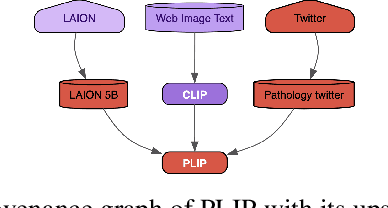

Abstract:Research and industry are rapidly advancing the innovation and adoption of foundation model-based systems, yet the tools for managing these models have not kept pace. Understanding the provenance and lineage of models is critical for researchers, industry, regulators, and public trust. While model cards and system cards were designed to provide transparency, they fall short in key areas: tracing model genealogy, enabling machine readability, offering reliable centralized management systems, and fostering consistent creation incentives. This challenge mirrors issues in software supply chain security, but AI/ML remains at an earlier stage of maturity. Addressing these gaps requires industry-standard tooling that can be adopted by foundation model publishers, open-source model innovators, and major distribution platforms. We propose a machine-readable model specification format to simplify the creation of model records, thereby reducing error-prone human effort, notably when a new model inherits most of its design from a foundation model. Our solution explicitly traces relationships between upstream and downstream models, enhancing transparency and traceability across the model lifecycle. To facilitate the adoption, we introduce the unified model record (UMR) repository , a semantically versioned system that automates the publication of model records to multiple formats (PDF, HTML, LaTeX) and provides a hosted web interface (https://modelrecord.com/). This proof of concept aims to set a new standard for managing foundation models, bridging the gap between innovation and responsible model management.
Can Large Language Models Understand DL-Lite Ontologies? An Empirical Study
Jun 25, 2024Abstract:Large language models (LLMs) have shown significant achievements in solving a wide range of tasks. Recently, LLMs' capability to store, retrieve and infer with symbolic knowledge has drawn a great deal of attention, showing their potential to understand structured information. However, it is not yet known whether LLMs can understand Description Logic (DL) ontologies. In this work, we empirically analyze the LLMs' capability of understanding DL-Lite ontologies covering 6 representative tasks from syntactic and semantic aspects. With extensive experiments, we demonstrate both the effectiveness and limitations of LLMs in understanding DL-Lite ontologies. We find that LLMs can understand formal syntax and model-theoretic semantics of concepts and roles. However, LLMs struggle with understanding TBox NI transitivity and handling ontologies with large ABoxes. We hope that our experiments and analyses provide more insights into LLMs and inspire to build more faithful knowledge engineering solutions.
A Short Review for Ontology Learning from Text: Stride from Shallow Learning, Deep Learning to Large Language Models Trend
Apr 23, 2024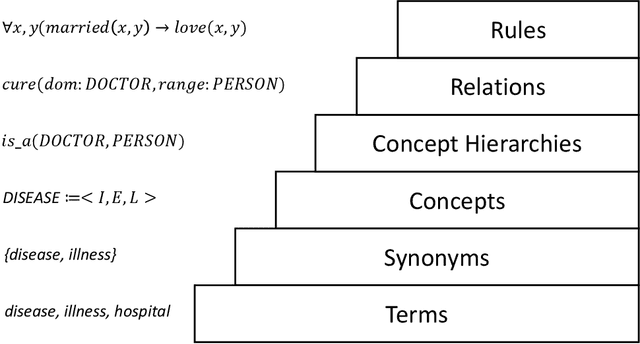
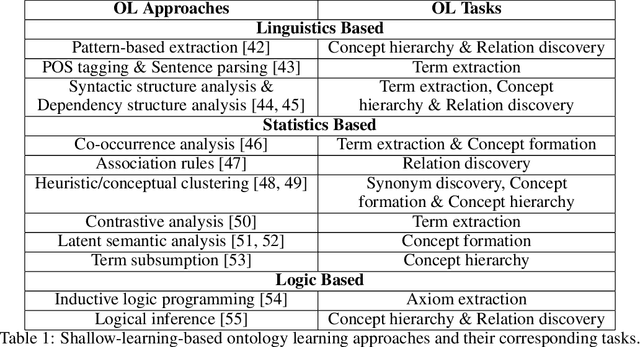
Abstract:Ontologies provide formal representation of knowledge shared within Semantic Web applications and Ontology learning from text involves the construction of ontologies from a given corpus of text. In the past years, ontology learning has traversed through shallow learning and deep learning methodologies, each offering distinct advantages and limitations in the quest for knowledge extraction and representation. A new trend of these approaches is relying on large language models to enhance ontology learning. This paper gives a review in approaches and challenges of ontology learning. It analyzes the methodologies and limitations of shallow-learning-based and deep-learning-based techniques for ontology learning, and provides comprehensive knowledge for the frontier work of using large language models to enhance ontology learning. In addition, it proposes several noteworthy future directions for further exploration into the integration of large language models with ontology learning tasks.
Embedding Ontologies via Incoprorating Extensional and Intensional Knowledge
Jan 20, 2024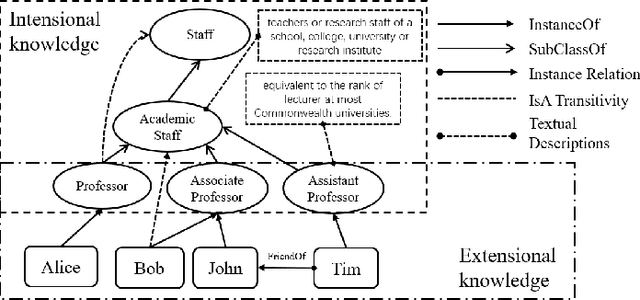
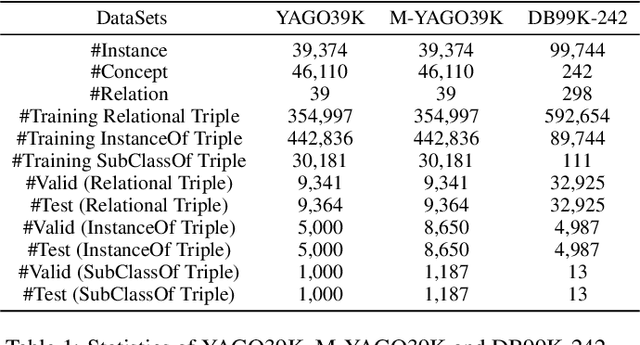
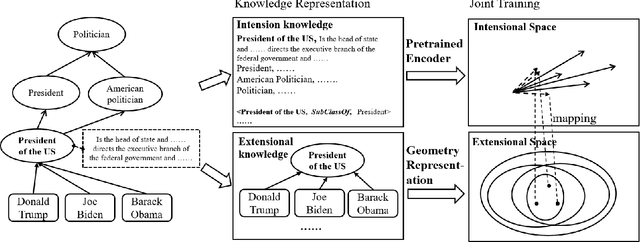
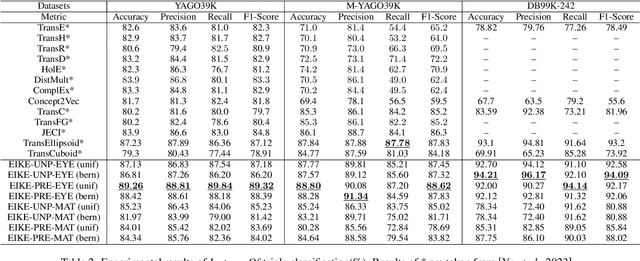
Abstract:Ontologies contain rich knowledge within domain, which can be divided into two categories, namely extensional knowledge and intensional knowledge. Extensional knowledge provides information about the concrete instances that belong to specific concepts in the ontology, while intensional knowledge details inherent properties, characteristics, and semantic associations among concepts. However, existing ontology embedding approaches fail to take both extensional knowledge and intensional knowledge into fine consideration simultaneously. In this paper, we propose a novel ontology embedding approach named EIKE (Extensional and Intensional Knowledge Embedding) by representing ontologies in two spaces, called extensional space and intensional space. EIKE presents a unified framework for embedding instances, concepts and their relations in an ontology, applying a geometry-based method to model extensional knowledge and a pretrained language model to model intensional knowledge, which can capture both structure information and textual information. Experimental results show that EIKE significantly outperforms state-of-the-art methods in three datasets for both triple classification and link prediction, indicating that EIKE provides a more comprehensive and representative perspective of the domain.
An Embedding-based Approach to Inconsistency-tolerant Reasoning with Inconsistent Ontologies
Apr 04, 2023Abstract:Inconsistency handling is an important issue in knowledge management. Especially in ontology engineering, logical inconsistencies may occur during ontology construction. A natural way to reason with an inconsistent ontology is to utilize the maximal consistent subsets of the ontology. However, previous studies on selecting maximum consistent subsets have rarely considered the semantics of the axioms, which may result in irrational inference. In this paper, we propose a novel approach to reasoning with inconsistent ontologies in description logics based on the embeddings of axioms. We first give a method for turning axioms into distributed semantic vectors to compute the semantic connections between the axioms. We then define an embedding-based method for selecting the maximum consistent subsets and use it to define an inconsistency-tolerant inference relation. We show the rationality of our inference relation by considering some logical properties. Finally, we conduct experiments on several ontologies to evaluate the reasoning power of our inference relation. The experimental results show that our embedding-based method can outperform existing inconsistency-tolerant reasoning methods based on maximal consistent subsets.
 Add to Chrome
Add to Chrome Add to Firefox
Add to Firefox Add to Edge
Add to Edge